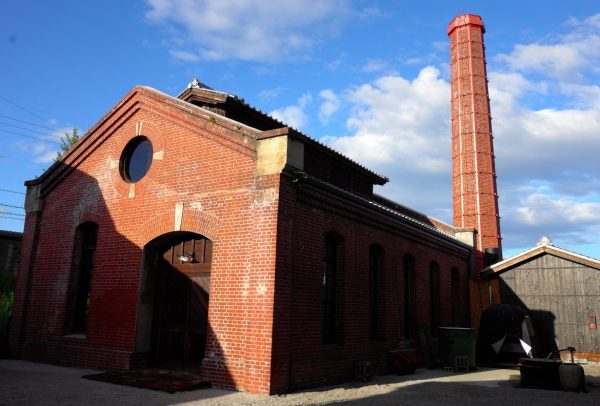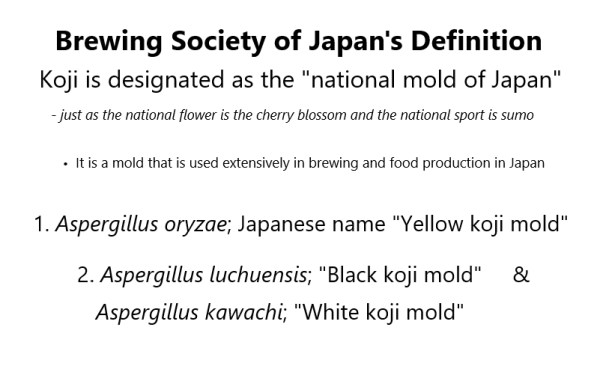Heading due west of the Momoyama Goryō train station (and the traditional shopping district that neighbors it), and then descending along the down-sloping canal will bring you to Matsumoto Brewery. Situated along the beautiful Fushimi canal, it is a popular destination among customers and sightseers alike. For today’s article I want to attempt to reenact a typical Q&A session conducted during a brewery tour. Topics covered start from the reason for the brewery’s Fushimi location through to sake’s raison d’etre, so I hope that everyone enjoys learning about these things as much I do talking about them. Please enjoy!
Visitor “A”: While showing us around in the Rengakura, you showed us some malt. Could you explain to us just what malt is?
Tour Guide “K”: We have a saying around here that best summarizes the sake production process: “Mold, Mash, Make!” We always start with malt production which necessitates the use of a mold. Please look at this diagram.
COLUMNEssay

Scenery from the sake brewery - 013 The 3 M's: “Mold, Mash & Make!” Part 1: Mold
Monthly photo essay on Japanese sake brewing by Mr. Keiichiro Katsuki, a Japanese sake brewing expert.
Please refer to episode 001 for more information on the author.

“Rengakura”: A western-style brick building at Matsumoto Brewery

Types of grasses used as edible grains and cereals
Tour Guide “K”: Put simply, malt is a grain/cereal that has been deliberately inoculated with a mold to produce a desired product.
Visitor “B”: What kind of things are considered to be a “grain” or “cereal”? Does this just refer to rice?
Tour Guide “K”: “Grains” and “cereals” are seeds derived from plants belonging to the grasses family. Grain and cereal products are the staple food for the majority of people in the world.
Visitor “B”: You explained to us that you cultivate mold on grains to make malt; is that the same mold that can be found growing on mochi rice cakes (when it goes bad)?
Tour Guide “K”: Though mold can propagate itself on mochi, this is a different mold to that we use to seed our steamed rice to make malt for sake. Looking at this diagram, you can see where molds are situated on the evolutionary, or “phylogenetic” tree.

Tour Guide “K”: Organisms are broadly divided into 3 groups. Molds are Eukaryotes, single or multi-celled organisms whose cell/cells contain a nucleus that stores and regulates DNA and RNA. Just like their yeast friends, molds are Eukaryotic microorganisms that belong to True Fungi and have species popularly used in food and drink production. As an aside, there are also Prokaryotic microorganisms that are popular in food and drink production such as Lactobacilli and nitrate-reducing bacteria.

Visitor “A”: Hmm, a little tricky for me to understand. I originally thought that yeast and mold was the same thing, but I think I understand how they are different and that they play different roles in alcohol production.
Visitor “C”: I now understand that mold is grown on grains to make malt! Does this process trace itself back to ancient times in Japan?

Tour Guide “K”: The techniques of using mold with grains is thought to have been introduced to Japan via other East Asian countries where thriving cultures of mold use arose. I think it’s reasonable to assume that malting knowhow came to Japan at about the same time as rice cultivation and associated agricultural techniques, implements, culture (and people to bring these things) did.
Visitor “A”: Am I correct in saying that Japan has developed unique malts?
Tour Guide “K”: Yes, so as we know, malt making practices have existed and have continued to change since ancient times, and over several years Japan has made some unique advances in this. For example, the biggest difference between Japan and other Eastern Asian countries would be the variety of molds predominantly used. After that, would be the difference in malt making style. The length and position of the Japanese archipelago is such that it is home to regions of very different climates and inherent ambient conditions, which has necessitated alterations to malt making methodologies. Further to that, it is also presumed that differences in how staple foods are cooked account for how malt making has advanced on different paths between countries and cultures.

Tour Guide “K”: As shown in this diagram, non-Japanese countries of East Asia commonly make malt without heat treatment and by seeding with mold species belonging to Rhizopus SP and Mucor SP. Japan on the other hand has come to employ heat treatment and Aspergillus SP molds.

Tour Guide “K”: So important have kōji molds become to the country, that the Brewing Society of Japan has designated them as the “National Mold of Japan”, in the same way as the cherry blossom has been designated as the national flower and sumō as the national sport.
Visitor “E”: A little while ago we were shown a video about malt making where steamed rice was seeded by scattering a powder like substance on it. That was fermentation starter wasn't it? Back at school I remember being taught that malt was made using kōso* enzymes produced by kōji molds, however after watching a video at a beer brewery tour, I learnt that this “kōso” was used in beer malts as well. I'm a little confused, as I didn’t think that kōji molds were used in beer making, so could you tell me the difference between the enzymes used in sake and beer production?
* "kōso" is an umbrella term that refers to enzymes produced by molds, fruits, plants etc. especially in relation to malt production, a fact that Visitor E mustn't have known at the time of their question
Tour Guide “K”: First, I will explain how malt used in beer differs from kōji malt. For beer malt, grains (usually barley) are induced to germinate before being dried out. This practice traces itself back at least as far as the time of the Egyptians as evidenced by its depiction on their murals.

Tour Guide “K”: Soaking grain seeds in water stimulates the production of hormones in the embryo that drives saccharification (converting to sugars) enzyme production at the seed coating. These enzymes move to the endosperm and convert starch to sugar, producing the energy needed for the seed to develop. When sprouts start to grow from the barley seeds, the germination process is arrested by drying them out, and this dry, semi-germinated preparation is termed the "malt". The malt is then crushed when it comes time to use it. Similarly, for kōji malt the goal is to induce the kōji mold to produce the same enzymes as produced in the barley malt. Though the physiological process will obviously differ, the use of kōji molds is well defined and produces excellent results.

Tour Guide “K”: Next, I will focus on rice malt. As you saw in the video, kōji malt production involves cooling down steamed rice to a suitable temperature before scattering it with the "children" (better known as spores) of kōji mold (Aspergillus oryzae). Just like with germination of plant seeds, the kōji spores are induced to start forming roots of their own: filamentous structures called hyphae (singular hypha). These hyphae grow along the surface and penetrate into the grains of steamed rice. It is reasoned that the production and growth of hyphae serves in the mold's development and production of offspring.
When the kōji mold's hyphae penetrate the rice grain they secrete enzymes at their tip. The secreted enzyme breaks down starches into sugars, producing the energy required for their development and the further elongation of hyphae. The enzymes that are produced here are used in sake brewing. Hyphae growing in air produce relatively minute amounts of enzymes, whereas the plenty of enzyme can be found accumulating around hyphae that have penetrated rice grains. The production of metabolites by developing kōji mold is instrumental in the subsequent process of yeast proliferation in yeast mash and moromi (unrefined sake), providing crucial enzymes and vitamins.
Visitor “B”: Watching the video, I thought that the movement of hyphae kind of resemble that of that of plant roots.
Tour Guide “K”: Yes, they are a little alike, huh? Well, I would now like you all to jot down on the paper provided, some things that have taken your interest today regarding sake brewing. We now live in a time of incredible convenience. Almost anything you wish to know regarding sake brewing can be found at a fingertip thanks to an abundance of information in magazines or the web, with an especially useful source being articles, essays and more published by the Brewing Society of Japan. You even have the option of emailing them with any questions.
Visitor “D”: As you explained during the slide presentation, there are specialist producers of fermentation starter cultures, responsible for the selection, preservation and production of certain mold varieties. Then there are brewers, who are responsible for selecting the mold cultures that they think will help them achieve their desired brewing results. Would you be able to tell us more about these kōji experts?
Tour Guide “K”: Well, we may be here for a while and I'm not sure how much you will be able to remember, so I will remind you again of the famous “3 M’s: Mold, Mash, Make". To best understand sake brewing, you must learn how these 3 things tie together, and this will form the structure of my explanation. So now let me talk about the history and advances of kōji...(to be continued in Part 2: "Mash").





